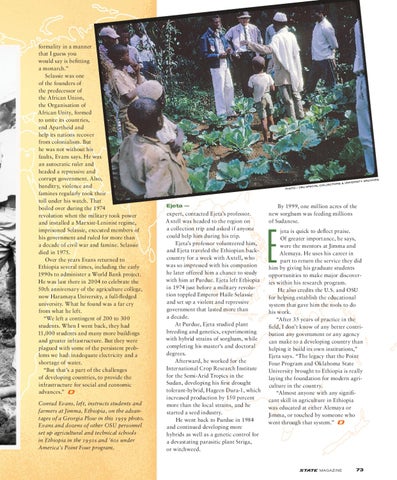formality in a manner that I guess you would say is befitting a monarch.” Selassie was one of the founders of the predecessor of the African Union, the Organisation of African Unity, formed to unite its countries, end Apartheid and help its nations recover from colonialism. But he was not without his faults, Evans says. He was an autocratic ruler and headed a repressive and corrupt government. Also, banditry, violence and famines regularly took their toll under his watch. That boiled over during the 1974 revolution when the military took power and installed a Marxist-Leninist regime, imprisoned Selassie, executed members of his government and ruled for more than a decade of civil war and famine. Selassie died in 1975. Over the years Evans returned to Ethiopia several times, including the early 1990s to administer a World Bank project. He was last there in 2004 to celebrate the 50th anniversary of the agriculture college, now Haramaya University, a full-fledged university. What he found was a far cry from what he left. “We left a contingent of 200 to 300 students. When I went back, they had 11,000 students and many more buildings and greater infrastructure. But they were plagued with some of the persistent problems we had: inadequate electricity and a shortage of water. “But that’s a part of the challenges of developing countries, to provide the infrastructure for social and economic advances.” Conrad Evans, left, instructs students and farmers at Jimma, Ethiopia, on the advantages of a Georgia Plow in this 1959 photo. Evans and dozens of other OSU personnel set up agricultural and technical schools in Ethiopia in the 1950s and ’60s under America’s Point Four program.
ial oS U Sp ec ph ot o /
Ejeta —
expert, contacted Ejeta’s professor. Axtell was headed to the region on a collection trip and asked if anyone could help him during his trip. Ejeta’s professor volunteered him, and Ejeta traveled the Ethiopian backcountry for a week with Axtell, who was so impressed with his companion he later offered him a chance to study with him at Purdue. Ejeta left Ethiopia in 1974 just before a military revolution toppled Emperor Haile Selassie and set up a violent and repressive government that lasted more than a decade. At Purdue, Ejeta studied plant breeding and genetics, experimenting with hybrid strains of sorghum, while completing his master’s and doctoral degrees. Afterward, he worked for the International Crop Research Institute for the Semi-Arid Tropics in the Sudan, developing his first drought tolerant-hybrid, Hageen Dura-1, which increased production by 150 percent more than the local strains, and he started a seed industry. He went back to Purdue in 1984 and continued developing more hybrids as well as a genetic control for a devastating parasitic plant Striga, or witchweed.
co ll ec tio
ive rS nS & Un
ive ity ar ch
By 1999, one million acres of the new sorghum was feeding millions of Sudanese.
E
jeta is quick to deflect praise. Of greater importance, he says, were the mentors at Jimma and Alemaya. He uses his career in part to return the service they did him by giving his graduate students opportunities to make major discoveries within his research program. He also credits the U.S. and OSU for helping establish the educational system that gave him the tools to do his work. “After 35 years of practice in the field, I don’t know of any better contribution any government or any agency can make to a developing country than helping it build its own institutions,” Ejeta says. “The legacy that the Point Four Program and Oklahoma State University brought to Ethiopia is really laying the foundation for modern agriculture in the country. “Almost anyone with any significant skill in agriculture in Ethiopia was educated at either Alemaya or Jimma, or touched by someone who went through that system.”
73
S
